![]()
![]()
![]()
Use LEFT and RIGHT arrow keys to navigate between flashcards;
Use UP and DOWN arrow keys to flip the card;
H to show hint;
A reads text to speech;
191 Cards in this Set
- Front
- Back
|
What is the term for having extra teeth?
|
hyperdontia (aka supernumerary teeth)
|
|
|
True or False, supernumerary teeth develop in addition to normal set of teeth
|
True
|
|
|
True or False, hyperdontia is not inherited because it is only caused by fetal damage
|
False, it can be inherited
|
|
|
90% of supernumerary teeth occur in the (maxilla/mandible)
|
maxilla
|
|
|
What's the most common type of supernumerary teeth?
|
Mesiodens (extra tooth in maxillary midline)
|
|
|
An extra tooth in the maxillary midline is called what?
|
mesiodens
|
|
|
What is the name for a supernumerary tooth that erupts DISTAL to the 3rd molar?
|
distomolar or distodens
|
|
|
A distomolar erupts (mesial/distal) to the 3rd molar
|
distal
|
|
|
What is the name for a supernumerary tooth that is seen in the molar area, buccal OR lingual to a normal tooth?
|
paramolar
|
|
|
A patient comes in with a tooth that appears to be a 4th molar. What can you assume this is?
|
A distomolar or distodens
|
|
|
Mesiodens are usually (small/large) and have (long/short) roots. Overall, their shape can be described as ___.
|
small, short. conical.
|
|
|
You see a radiograph with a diastima between tooth # 8 and 9 with a small conical tooth in between forcing them apart. What would this small tooth be called?
|
Mesiodens
|
|
|
True or False, supernumerary teeth can prevent the eruption of normal permanent teeth
|
True
|
|
|
Supernumerary teeth, when occurring in the MANDIBULAR region, tend to occur where?
|
premolar-molar region
|
|
|
True or False, supernumerary teeth actually do not cause crowding
|
False, they do (or at least, they can)
|
|
|
True or False, with supernumerary teeth, you should detect them early and remove them
|
True
|
|
|
What are three syndromes associated with supernumerary teeth?
|
Gardner, Apert, Down
|
|
|
If you suspect someone may have Gardner syndrome, what should you do and why?
|
Have them see a doctor because intestinal polyps are common with this syndrome and can lead to cancer
|
|
|
Match the following:
Hypodontia Oligotontia Adontia 1. absence of ALL teeth 2. 1 or a few missing teeth 3. several missing teeth |
Hypodontia : one or a few missing teeth
Oligodontia: several missing teeth Anodontia: absence of all teeth |
|
|
What syndrome is associated with multiple missing teeth, and is a problem with ectodermally derived structures like hair, nails, and sweat glands?
|
Entodermal dysplasia
|
|
|
In ectodermal displasia, what are the teeth shaped like?
|
conical
|
|
|
True or False, an ankylosed tooth is fused to bone
|
True
|
|
|
If a tooth still had its PDL and lamina dura intact on a radiograph, then it (is/is not) ankylosed
|
is NOT (must be fused to bone, meaning PDL and LD would not be visible)
|
|
|
Primary teeth:
Have more (convergent/divergent) roots Have (larger/smaller) crowns |
divergent, smaller
|
|
|
Rank the order of the following teeth from most commonly missing, to least commonly missing (note: all referring to perm. teeth)
Max lateral incisors Mand 3rd molar Max 3rd molar Mand 2nd premolar |
Max 3rd molar
Mand 3rd molar Mand 2nd molar max permanent lateral incisor (Hint: 3, 2, 1. 3rd molar, 2nd premolar, 1st [and only] lateral incisor) |
|
|
True or False, there is a high correlation between primary tooth absence and permanent tooth absence
|
True
|
|
|
A larger than normal tooth is called ___
|
macrodontia
|
|
|
a smaller than normal tooth is called ____
|
microdontia
|
|
|
A macrodont may resemble what two other tooth deformation?
|
fusion, gemination
|
|
|
What two basic things can a macrodont cause or accelerate?
|
crowding, and perio disease
|
|
|
Supernumerary teeth are more often (micro/macro)dont
|
micro
|
|
|
Microdontia usually effects what two teeth?
|
permenant lateral incisors
Max 3rd molars |
|
|
True or False, microdonts are never malformed, only small versions of a normal tooth
|
False, they are smaller and either normal OR malformed
|
|
|
What is the common name for a microdont maxillary lateral incisor?
|
Peg lateral (I still think this should have been a waxing project last semester)
|
|
|
Microdontia is usually (bi/uni)lateral
|
bi
|
|
|
What is a good method to save and alter a microdont so that it works more effectively in the mouth?
|
Put a crown on it
|
|
|
Other than lateral incisors, what teeth are the next most common to be microdonts
|
3rd molars
|
|
|
What tooth has the most variable crown shape?
|
Max 3rd molars
|
|
|
When two teeth switch position in the arch, we call this
|
Transposition or translocation
|
|
|
True or False, crowding is very common with transposition
|
False! Teeth don't crowd, they just switch spots
|
|
|
Which is more common with translocation; crowding or occlusion issues?
|
occlusion issues
|
|
|
What's the difference between tipping and drifting?
|
Tipping is when the tooth stays in the same place but 'falls' to one side.
In drifting, the tooth actually migrates |
|
|
A patient comes in with a tooth surrounded by two empty spaces where teeth have been extracted. What two problems might the patient experience with that tooth?
|
tipping or drifting
|
|
|
What is an ectopic eruption?
|
Tooth comes in in the wrong place. Ex: mand. incisors coming in behind the primary teeth
|
|
|
Which is more likely to cause crowding; ectopic eruption or transposition
|
ectopic eruption
|
|
|
True or False, an ectopic eruption can cause disruption of the arch curvature
|
True
|
|
|
When teeth are out of alignment and a tooth has no opposition in the opposing arch, what can happen?
|
Supraeruption
|
|
|
(impacted/embedded) teeth are physically stopped from erupting, whereas (impacted/embedded) teeth simply fail to erupt
|
impacted, embedded
|
|
|
True or False, embedded teeth can also be ankylosed
|
True
|
|
|
Embedded teeth happen more frequently in the (maxilla/mandible) in the (distal/mesial) direction
|
mandible, mesial
|
|
|
What is the term for the abnormal movement of an unerupted tooth?
|
migration
|
|
|
What happens to 'migrated' teeth?
|
They stay embedded
|
|
|
The union of two tooth buds can lead to ___
|
fusion
|
|
|
If two normal teeth are fused, you end up with an overall (lower/higher) # of teeth
|
lower, because 2 teeth became 1 by fusion
|
|
|
Fusion is more common in (primary/permanent) dentition
|
primary
|
|
|
In permanent teeth, fusion is most common between what two teeth?
|
central and lateral incisors
|
|
|
True or false, teeth that have undergone fusion also share a pulp chamber
|
False! They bring in their own pulp chamber, canals, and roots
|
|
|
What's the proper name for fusion (in regards to teeth)?
|
Synodontism
|
|
|
What's the difference between fusion and gemination?
|
fusion is when two teeth come together
gemination is when 1 tooth tries to split apart |
|
|
When a single tooth bud tries to split apart, it's called ___
|
gemination
|
|
|
Gemination is also known as ____
|
schizodontism
|
|
|
In gemination, what happens to the overall # of teeth?
|
stays the same
|
|
|
Gemination is most common in (anterior/posterior) teeth
|
anterior
|
|
|
Geminated teeth appear (smaller/larger) than normal
|
larger
|
|
|
A patient comes in and despite being afraid that he will die from radiation exposure when given an X-ray, you manage to talk some sense into him and take a radiograph of a funny looking tooth. The tooth has an enlarged pulp chamber that is 'Y'-shaped with 2 coronal portions, and has 1 root. What is wrong with the paranoid guy's tooth?
|
gemination
|
|
|
Gemination happens more frequently in (primary/secondary) teeth
|
primary
|
|
|
True or False, gemination ONLY occurs in primary teeth
|
False, occurs in both primary and permanent
|
|
|
Gemination is most common in:
A. 3rd molars B. Incisors C. Pre-molars D. Mandibular molars E. Canines |
B. Incisors
|
|
|
Concresence is due to ___
|
hypercementosis
|
|
|
The union between the roots of 2 or more adjacent teeth by cementum is called what?
|
Concresence
|
|
|
Concresent teeth are (harder/easer) to extract than normal teeth
|
harder
|
|
|
What is the etiology of concresence?
|
unknown
|
|
|
When a tooth has an abnormally large pulp chamber, we call this ___
|
taurodontism
|
|
|
In taurondontism, what happens to the crown?
|
Nothing, it's normal. It just had a larger pulp chamber
|
|
|
Taurodontism can occur in (primary/permanent) teeth
|
Both!
|
|
|
A patient comes in with a painful tooth and you think a root canal is your best option. After taking a radiograph, you notice that might be difficult, due to an enlarged pulp chamber. What is this known as?
|
Taurodontism
|
|
|
Taurodontism is most common in which teeth?
|
molars
|
|
|
Teeth with taurodontism have (more/less) constriction at the DEJ
|
less (little or none at all)
|
|
|
You extract a tooth from a patient's mouth without doing a radiograph and notice the root is sharply bent and curved. What is this called?
|
dilaceration
|
|
|
What is the etiology of dilaceration?
|
disturbance in tooth development or trauma
|
|
|
Dilacerations are common in two groups of teeth. What are they?
|
max premolars
incisors |
|
|
In dens (in/e)vaginatus, you have an infolding of the outer surface of enamel into the interior of the tooth before calcification
|
invagination
|
|
|
What's another name for dens invaginatus?
|
dens in dente
|
|
|
A patient comes in and you notice a RO 'tear drop' outline on their tooth where the pulp would typically start. This is probably what?
|
Dens invaginatus
|
|
|
Dens in dente produces (shallow/deep) lingual pits
|
deep
|
|
|
Which is MORE susceptible to caries? Normal tooth, or tooth with dens invaginatus?
|
dens invaginatus
|
|
|
Dens invaginatus (aka dens in dente) is most common in which teeth?
|
max lateral incisors
|
|
|
What can be used to treat dens invaginatus?
|
fill with restoration
|
|
|
Dens evaginatus is an (in/out) folding of enamel
|
out
|
|
|
Why should you place a sealant in a tooth with dens evaginatus?
|
The fissures are suseptible to caries
|
|
|
Dens evaginatus is common in what teeth?
|
mand. premolars
|
|
|
Turner's hypoplasia is a type of what condition?
|
enamel hypoplasia
|
|
|
Incomplete or defective enamel formation is known as ___ ___
|
enamel hypoplasia
|
|
|
In enamel hypoplasia:
Normal tooth shape (is/is not) altered Is most common in what type of tooth? |
is altered
premolars |
|
|
What is a form of enamel hypoplasia based on heredity?
|
amelogenesis imperfecta
|
|
|
When ameloblasts fail to form enamel correctly, this is called
|
amelogenesis imperfecta, a type of enamel hypoplasia
|
|
|
Which type (1, 2 or 3) of amelogenesis imperfecta has normal but thin enamel
|
1
|
|
|
Which type (1, 2 or 3) of amelogenesis imperfecta has soft and mushy enamel
|
2
|
|
|
Which type (1, 2 or 3) of amelogenesis imperfecta has normal enamel, but it's poorly mineralized, tends to break, and looks 'snow-capped' on radiographs?
|
3
|
|
|
What type of restoration is best for amelogenesis imperfecta?
|
fixed prosthetics
|
|
|
You look at a patient's radiograph and notice square shaped crowns, poor proximal contacts, but a normal pulp chamber. What is wrong with this patient's teeth?
|
amelogenesis imperfecta
|
|
|
True or False, both amelogenesis imperfecta and dentinogenesis imperfecta are hereditary
|
True
|
|
|
Failure of the odontoBLASTS to form dentin and DEJ correctly is called ___ ___
|
dentionogenesis imperfecta
|
|
|
True or False, in dentinogenesis imperfecta, the integrity of the enamel is still the same
|
False, the underlying dentin is weak so the enamel is more likely to fracture
|
|
|
Teeth will appear what color in dentinoenesis imperfecta?
|
yellow to blue-gray
|
|
|
Which type (1 or 2) of dentinogenesis imperfecta is MOST common?
|
2
|
|
|
What treatment should be used to correct dentinogenesis imperfecta?
|
fixed prosthetics
|
|
|
Which type (1 or 2) of dentinogenesis imperfecta is associated with osteogenesis imperfecta?
|
1
|
|
|
Which type (1 or 2) of dentinogenesis imperfecta is when only the dentin isn't properly mineralized?
|
2
|
|
|
A patient comes in and has a radiograph taken. You notice one tooth has bulbous crowns, short tapered roots, the tooth is constricted in the cervical region, and the pulp canals show progressive obliteration. What is wrong with this tooth?
|
dentinogenesis imperfecta
|
|
|
Dentin dysplasia is a (hereditary/trauma induced) disorder
|
hereditary
|
|
|
True or False, Dentin dysplasia only effects permanent teeth
|
False, both perm and primary teeth
|
|
|
Which type (1 or 2) of dentin dysplasia has short abnormal roots?
|
1
|
|
|
Which type (1 or 2) of dentin dysplasia has obliteration of pulp chambers before eruption?
|
1
|
|
|
Which type (1 or 2) of dentin dysplasia has normal morphology?
|
1
|
|
|
Which type (1 or 2) of dentin dysplasia has normal enamel and dentin at DEJ, but dysplastic throughout the rest of the tooth?
|
1
|
|
|
Which type (1 or 2) of dentin dysplasia may present with periapical radiolucencies even though they are non-carious?
|
1
|
|
|
What is the recommended treatment for dentin dysplasia type 1, although it is difficult to do?
|
root canal
|
|
|
Which type (1 or 2) of dentin dysplasia displays changes in the pulp chambers and canals after eruption?
|
2
|
|
|
Which type (1 or 2) of dentin dysplasia commonly has pulp stones?
|
2
|
|
|
What is the proper name for 'ghost teeth'?
|
regional odontodysplasia
|
|
|
Which type (1 or 2) of dentin dysplasia has flame or thistle shaped pulp chambers in single rooted teeth?
|
2
|
|
|
A tooth has a globule of enamel that is not normal. What would we call this?
|
enamel pearl
|
|
|
True or False, enamel pearls may have their own dentin and pulp horn
|
True
|
|
|
Why can you not just pluck off an enamel pearl?
|
it could have it's own pulp; isn't always JUST a ball of enamel
|
|
|
Where are enamel pearls most commonly found?
|
furcation areas of molars
|
|
|
You look at a patient's radiograph and it appears that they have an enamel pearl on tooth #3. What other two things should you write down as possibilities?
|
calculus; pulp stones
|
|
|
Enamel pearls are typically in the (cervical/apical) portion of the tooth
|
cervical
|
|
|
Tooth resorption is the removal of tooth structure by odonto(blasts/clasts)
|
odontoclasts
|
|
|
True or False, roots will only resorb internally
|
False, internally OR externally
|
|
|
If the apex of a root looks excessively blunted, what might you assume is happening?
|
external resorption of the root
|
|
|
What happens to the PDL and lamina dura with external root resorption if there is NO periapical pathology?
|
they remain intact
|
|
|
What are the main causes of internal root resorption?
|
trauma
pulpotomy |
|
|
What are two treatments for internal resorption?
|
RCT
extraction |
|
|
If a patient has ruptured blood vessels on the pulp, they are at risk for ___ ___
|
internal resorption
|
|
|
A patient comes in and you notice one of their teeth is pink. What is likely wrong with this tooth?
|
internal resorption
|
|
|
True or False, pulp stones are 'invisible' on radiographs
|
False, they are RO
|
|
|
What is the etiology of pulp stones?
|
unknown
|
|
|
What is the etiology of regional odontoplasia?
|
unknown
|
|
|
If you look at a radiograph and see ghost-like teeth with large pulp chambers and canals with thin hypoplastic enamel and dentin, you might assume the patient has ___ ___
|
regional odontodysplasia
|
|
|
Talon cusps are commonly found where?
|
permanent max. central incisors
|
|
|
True or False, all talon cusps contain pulp horns
|
False, some do, some don't
|
|
|
The talon cusp is an exaggeration of what normal structure of the tooth?
|
cingulum
|
|
|
What is the term for physiological wearing away of tooth structure from tooth to tooth contact?
|
attrition
|
|
|
A patient comes in with flat occlusal planes and exposed dentin on all their anterior teeth. What do we call this?
|
attrition
|
|
|
Why are restorations difficult on patients with attrition?
|
You've lost the vertical dimension for support
|
|
|
With attrition, the PDL spaces tend to get (narrower/wider)
|
wider
|
|
|
What is the pathological wearing of tooth structure via an abnormal mechanical process?
|
abrasion
|
|
|
A person brushes their teeth very hard and they have noticeable wear on their teeth because of it. Is this attrition, abrasion, or erosion?
|
abrasion
|
|
|
What class of caries most commonly follows abrasion?
|
class 5 (because patient is probably brushing or flossing too hard around cervical area of tooth)
|
|
|
A patient comes in and tells you they floss 3 times a day for 5 minutes. You notice cervical burnout on the x-ray of these teeth. Is this attrition, abrasion, or erosion?
|
abrasion
|
|
|
A patient comes in complaining of tooth sensitivity of most of her teeth, and you notice they are flattened off and the dentin is exposed in many of them. Is this attrition, abrasion, or erosion?
|
attrition
|
|
|
True or False, abrasion is easily distinguishable form caries radiographically
|
False, they are often confused
|
|
|
A patient comes in with some teeth that appear to have a loss of tooth structure, but you deem it is non-pathological and not caused by excessive brushing or flossing. The patient tells you that they drink OJ at every meal. What do you suspect caused the loss of tooth structure?
|
erosion
|
|
|
A bulimic patient has the lingual of his (guys watch their figure too) maxillary anterior teeth exposed. Is this attrition, abrasion, or erosion?
|
erosion
|
|
|
How are abrasion and erosion different?
|
Abrasion is physical wear
Erosion is chemical wear |
|
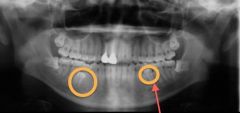
Are these teeth in orange impacted normal teeth or extra teeth? What is this called?
|
extra; hyperdontia
|
|
|
What is the name for these type of extra teeth?
|
mesiodens
|
|

Here, several teeth are missing. What is this known as?
|
oligodontia
|
|

1 tooth is missing under T. What is this problem known as?
|
hypodontia
|
|
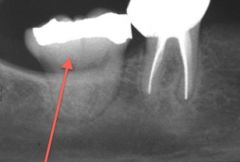
What is it called when a tooth looks like the one indicated by the red arrow?
|
macrodontia (look how much bigger it is that the tooth to its right)
|
|
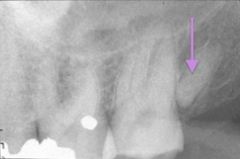
This tooth indicated by the purple arrow could be classified in what way based on its size?
|
microdontia
|
|
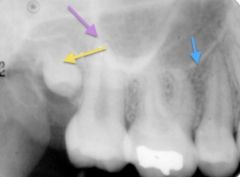
Is yellow a macro or microdont
What is indicated by the purple arrow? blue arrow? Over or underangulated image? |
microdont
purple - malar blue - max sinus overangulated |
|
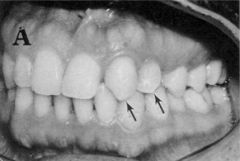
What do we call this? (notice where the teeth indicated by the black arrows are located)
|
transposition/translocation
|
|
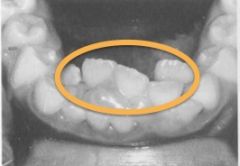
These teeth erupted in the wrong spot. We call this ___ eruption
|
ectopic eruption
|
|
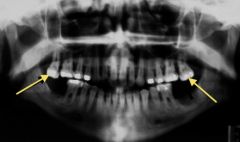
Because the teeth in yellow have no opposing contact, they will undergo ___
|
supraeruption
|
|
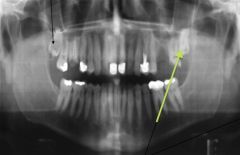
Is the tooth indicated by the green arrow embedded or impacted?
|
embedded
|
|
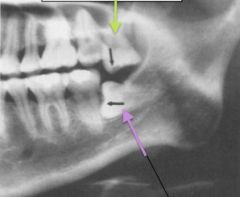
Because the purple arrowed tooth is ___, the green arrowed tooth wil undergo ____
|
impacted, supraeruption
|
|
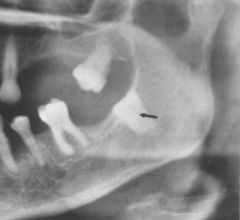
Is this tooth ankylosed?
|
Yes! (No PDL!)
|
|
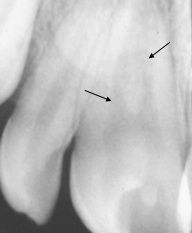
This is an image of (fusion/gemination)
|
fusion
|
|
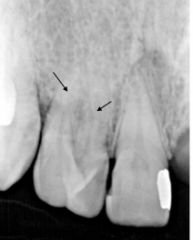
This is an image of (fusion/gemination)
|
fusion
|
|
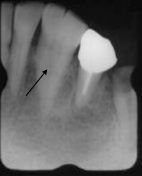
This is an image of (fusion/gemination)
|
gemination
|
|

This condition called ___ is due to a process known as ___
|
concrescence, hypercementosis
|
|
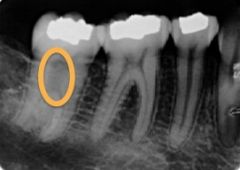
What do we call it when the pulp chamber appears the way it does in the orange circle here?
|
Taurodontism
|
|
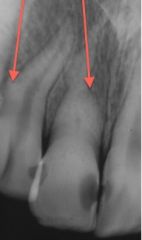
The morphology of the roots here is known as what?
|
dilaceration
|
|
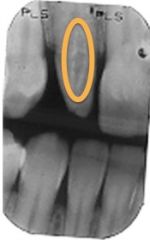
This is known as dens ___
|
invaginatus (or Dens in dente)
|
|
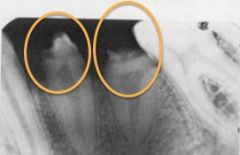
There is a deficit here in the orange circles. This is known as what?
|
enamel hypoplasia
|
|
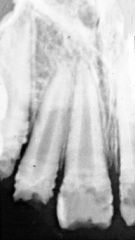
This type of enamel hypoplasia is called what?
|
amelogenesis imperfecta
|
|
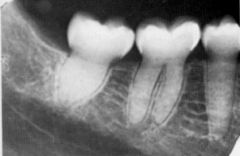
The bulbous crowns here are indicative of what?
|
dentinogenesis imperfecta
|
|
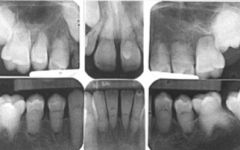
These short teeth indicate type __ of what problem?
|
type 1 dentin dysplasia
|
|

The odd pulp indicated type __ of what problem?
|
type 2 dentin dysplasia
|
|
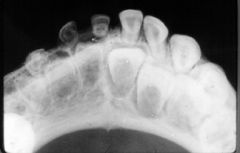
This is known as "ghost teeth" or __ __
|
regional odontodysplasia
|
|
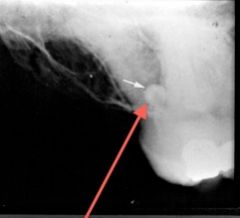
What is this small RO structure?
|
enamel pearl
|
|
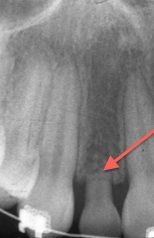
What happened to this tooth?
|
root resorption
|
|
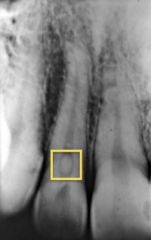
What is this known as in the yellow box?
|
pulp stone
|
|
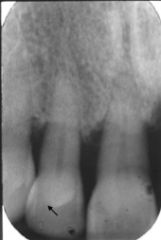
What is this RO object called?
|
talon cusp
|
|
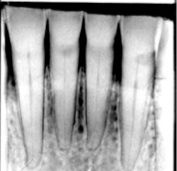
Attrition, abrasion, or erosion?
|
Attrition
|
|
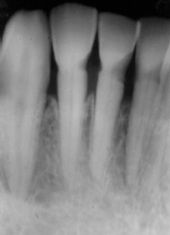
Attrition, abrasion, or erosion?
|
abrasion
|
|
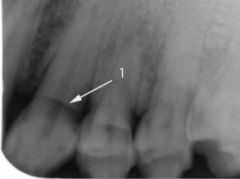
Attrition, abrasion, or erosion?
|
abrasion
|
|
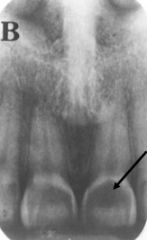
Attrition, abrasion, or erosion?
|
erosion
|
|
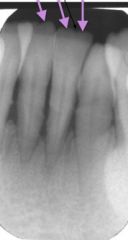
What are these little 'peaks' of enamel known as? (hint: not a disease process)
|
mamelons
|

